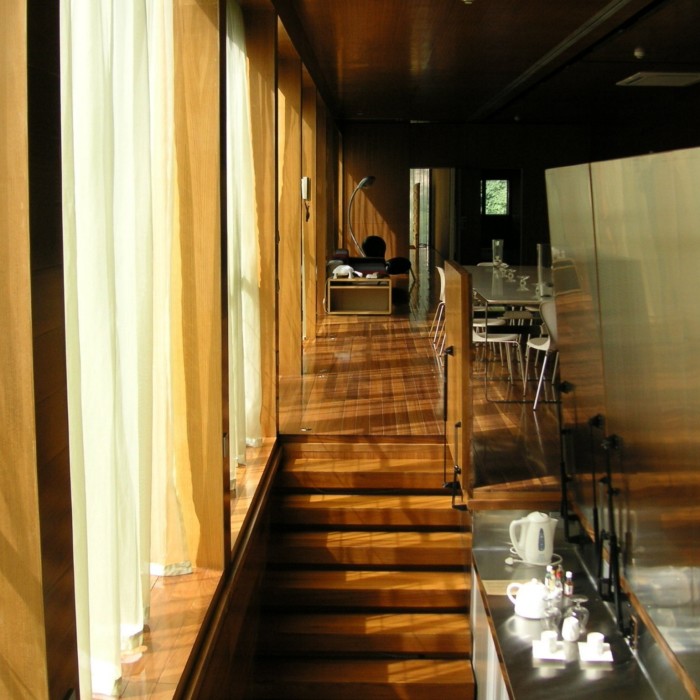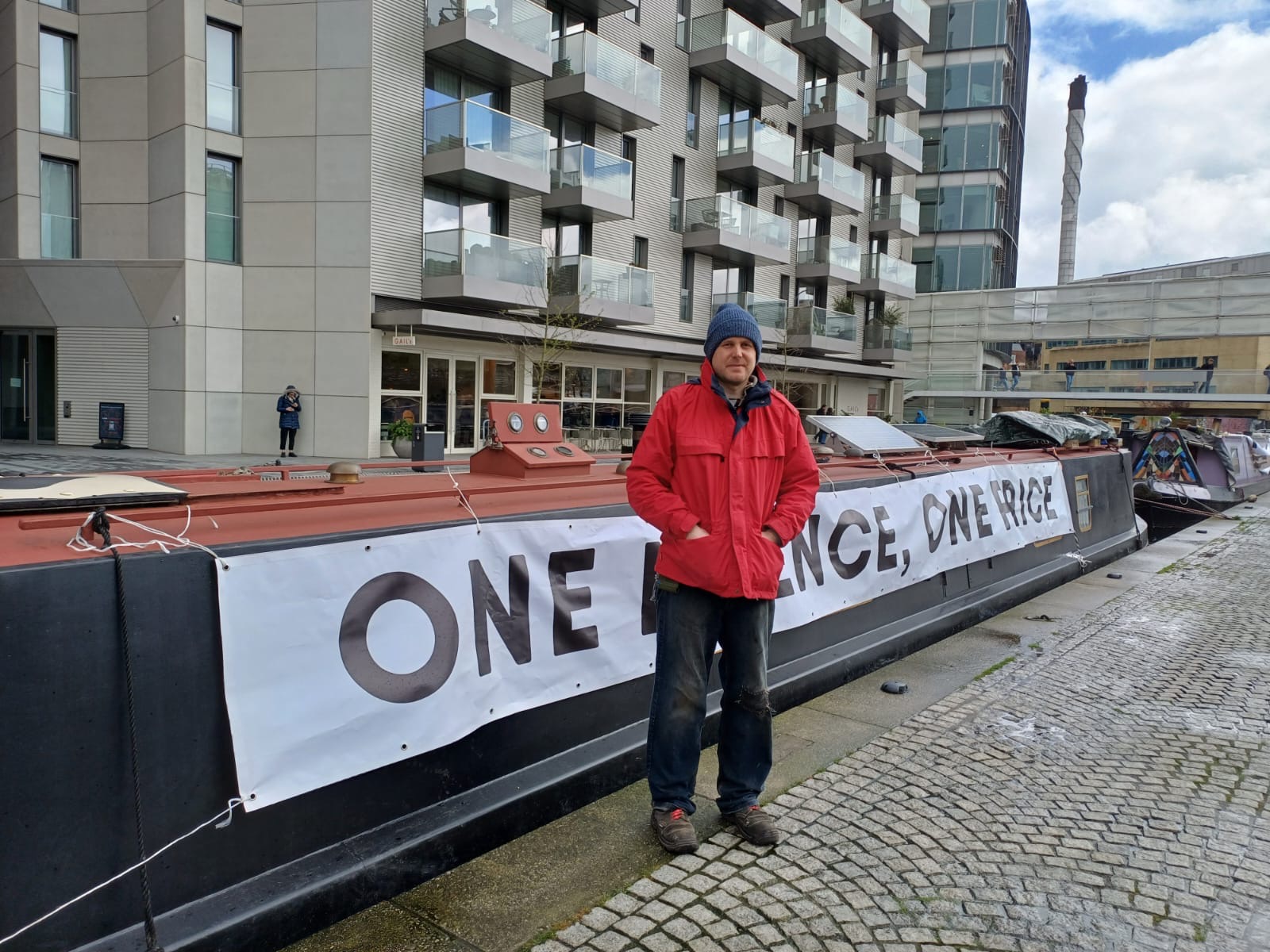In March 2020, during the first Covid pandemic lockdown, tenor Maurizio Marchini took to his small balcony in Florence and sang to his city. Unable to work, he performed Puccini’s “Nessun dorma” for the pure delight of his neighbours and — through YouTube — the rest of the world.
For the writer and curator Clare Farrow, whose latest exhibition Small Spaces in the City: Rethinking Inside the Box runs until January 27 at Roca London Gallery, this image — the small apartment; the creative person; a place normally humming with activity and excitement; the sense of connection — summed up both the frustrations and the pleasures of city living.
Three years later, as property rents, mortgage rates and the cost of living soar in cities globally and the supply of accommodation fails to keep up with demand, Farrow feels like this ecosystem is under threat. “I have a horror of a city like London or Berlin empty of the young; [becoming] a citadel for the privileged,” she says.
Some consider tiny apartments to be the answer. An informal European Commission report into Japan’s economy described the “cage à lapins” of Tokyo as long ago as 1979. Today the average-sized studio apartment in Tokyo is just 18 sq metres, against 35 in London, Milan and Sydney, 42 in New York. Research by UCL associate professor Jon Reades and Phil Hubbard, professor of urban studies at King’s College London, shows that after a slight dip in 2014, the proportion of small homes (defined as being 37 sq m or less) has now risen to one in 10 in inner west London and one in 20 for London overall.
Hubbard, interviewed by Farrow in the course of her research for the exhibition, suggests, however, that data is hard to come by. Until 2021, when space standards of 37 sq m for new homes were rolled out nationally, “offices could be turned into housing without planning permission or any stipulation as to usable floor space”, he says, with the result that small homes hard to track. Hubbard and Reades used data from energy performance certificates to gain information about gross internal area, finding, for instance, “multiple clusters of very small homes in London alongside major arterial roads”.
The children’s room of a Berlin micro-apartment by Paola Bagna
Much of their research highlights the deleterious impact of this small space trend. Besides issues of overcrowding, Hubbard says high numbers of these homes have poor air quality, high levels of noise pollution and are often far from green space, “which is really important for exercise and socialising if you live in a very small home”.
But as Farrow’s exhibition makes clear, the story is not all despair: she was surprised to discover a global community of enthusiasts: “I am fascinated by how small spaces are trending on social media,” she says, adding that she found inspiration in small-space devotees from Diogenes in his tub to Le Corbusier with his seaside Cabanon.
Contemporary architects, too, have been inspired by the challenge to create appealing, flexible interiors within a small compass that promote happiness and wellbeing. The calm, light-filled Shoji Apartment of practice Proctor & Shaw, completed in 2021 and featured in this show, won the Royal Institute of British Architects London Awards 2023 and a 2022 Dezeen Award.
And three of this year’s candidates for the RIBA Stirling Prize are projects for small apartments. A House for Artists by Apparata Architects, for instance, delivers a flexible live/work space for 12 artists arranged across five floors. In exchange for reduced rent, artists offer free creative programmes for the neighbourhood through a ground-floor community hall and outdoor exhibition space.
The supermarket is my pantry, and the library is my study room. I see the whole city as my back yard
Adam Khan Architects worked with the London Borough of Camden to design a flexible community children’s facility and several housing units for social rent in the deprived neighbourhood of Somers Town. And in Clapham, Sergison Bates architects have turned a former sheet-metal workshop down a mews into nine private apartments of various sizes, arranged around a courtyard space. All three nominated projects seek to combine affordability with celebration — encouraging a balance between privacy and communality, the key to happy city living.
One inspiration for Farrow was Malaysian-born Colin Chee. A media producer based in Melbourne, his YouTube series “Never Too Small”, launched in 2017, featuring sparely shot interviews with designers in the spaces they have created, has more than 2mn followers. His book, Never Too Small: Reimagining Small Space Living, offers detailed floor plans of every home featured, and he has published a digital guide on how to design and organise small spaces.
Since buying his first city apartment, measuring just 37 sq m, he has become a passionate champion of small homes on ethical, ecological and social grounds. Chee points out that according to data from the UN, by 2050, seven in 10 people will live in cities — and says that “by densifying our cities sustainably and by reducing our footprint to accommodate our growing populations” we can limit the predicted rate of global warming.
He takes a positive delight in the incentive small-space living affords to spill out into the streets of his neighbourhood. “Sometimes my Aussie friends come over and say, ‘Oh my God you live in my pantry!’ But living in a city, the supermarket is my pantry, and the library is my study room. I see the whole city as my back yard.”
In his first apartment, he and his partner would cook dinner every Thursday for an elderly neighbour before all three (plus their small dog) returned to her small apartment to play Scrabble. Two key enhancements of pleasurable small-space living, he has learnt, are multi-functionality and transformability.
For an exhibition last year during Melbourne Design Week, Chee commissioned Ben Edwards and Nancy Beka of Studio Edwards to produce the squeezebox, a stool like a concertina that becomes a bookshelf. Small Spaces also features the flow wall desk of Robert Van Embricqs, first shown this year during Milan Design Week, which folds up like a fan when not in use.
I ask clients to organise their belongings into necessary and on view, necessary but not visible and unnecessary
master of transformation is Hong Kong architect Gary Chang, founder of Edge Design Institute, who first drew international attention for his 2002 Suitcase House at the Commune by the Great Wall, in Beijing. This used sliding walls and opening floor panels to allow for the transformation of tight spaces for different functions.
Perhaps more famous, however, is his 2007 work on the 32 sq m family apartment he has inhabited since childhood, which once accommodated his parents, four children and a lodger. Chang created “The Domestic Transformer”, replacing the partitions with wall elements that move, slide and swing to transform the apartment into a potential 24 different spaces — including a library, guest bedroom, dining room, home spa, home office, cinema and cocktail lounge for 20 guests.
“We call this notion 100 per cent optimisation of space,” he says. While ideal for a single person, Chang remembers that it had one advantage for a family: “We learnt that we have to respect each other and behave well. For instance, I whispered with my sisters most of the time — could you imagine if we yelled at each other?”
Clients are embracing small spaces in Europe too. Spanish architect Paola Bagna, based in Berlin, specialises in maximising the potential of small flats in old, high-ceilinged apartment blocks, focusing on light, ventilation and the sustainable use of old and new materials. The key issue is storage. For the client, this becomes an exercise in self-definition: “I ask them to organise their belongings into necessary and on view, necessary but not visible and unnecessary.” She sees this not as a penance but a joyful embrace of lightness.
 An 18 sq m apartment in Hong Kong by Gary Chang of Edge Design Institute
An 18 sq m apartment in Hong Kong by Gary Chang of Edge Design Institute  Chang’s Suitcase House
Chang’s Suitcase House
She does, however, admit that the pleasure she takes in her own 45 sq m centrally located apartment is incalculably enhanced by the surrounding neighbourhood with its cafés and other public spaces: “It is important to feel that you have your people nearby,” she says. Next year she embarks on a project to transform a 13 sq m space in Paddington into a home for an artist.
Leonardo da Vinci once wrote that “An artist’s studio should be a small space because small rooms discipline the mind and large ones distract it.” Anna Parker, director of Birmingham-based Intervention Architecture, is currently working on a micro-apartment for two artists on the top floor of the Art Deco apartment building Florin Court, in Charterhouse Square, London. In 2020 she redesigned the Barbican apartment of William Bracewell, principal dancer with the Royal Ballet, with an emphasis on craftsmanship, natural materials, mobility and colour.
“It is a real achievement to only want usable space rather than just more space,” she says. “I think there is a courageous satisfaction in knowing that you are being sustainable and reducing our impact on material resources.”
As Small Spaces suggests, there are increasing numbers of designers and architects out there determined to make that choice alluring. If they are in turn supported by urban planners, with more rigorous regulation, transport infrastructure and public facilities such as gyms, libraries and parks, we can keep our cities diverse, youthful and full of creative energy.
Find out about our latest stories first — follow @FTProperty on X or @ft_houseandhome on Instagram
https://www.ft.com/content/1bd360a3-1b2a-4e02-b149-a03a39c9474d




